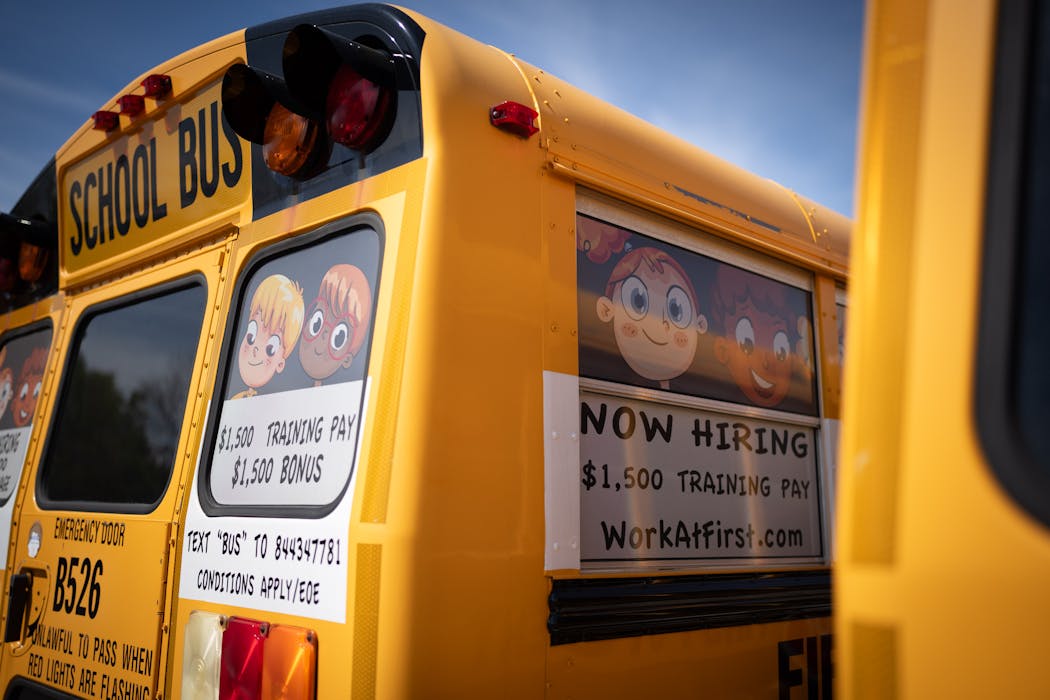St. Paul is restoring yellow school bus service to three high schools — Central, Harding and Washington Technology Magnet — when classes start Tuesday, two years after the pandemic exacerbated a shortage of drivers and forced students onto public transit.
It's a cautious return to school transportation normalcy that is reassuring to families that rely on bus service. But that doesn't mean drivers aren't in demand, and extra pay has been key to filling jobs.
First Student, the largest provider of student transportation in North America, still needs about 100 drivers for the 1,200 routes it covers in Minnesota. Unlike in previous years, the company plans to get by without bringing in employees from other states.
"I wouldn't say it's worse," Garrett Regan, an executive board member for the Minnesota School Bus Operators Association, said Wednesday of pressure to fill slots across the state. "My gut feeling is it's about the same."
Teamwork and compromise are very much the rule these days following a tumultuous 2021-22 school year that found bus companies and districts being slammed with driver shortages fueling cuts, delays and sudden cancellations.
Field trips and games are being shifted occasionally to different times. Coaches and teachers are obtaining licenses to drive. Routes are shuffled and new service created.
Still, not every maneuver works, and in some other parts of the United States, the driver shortage is acute.
In Louisville, Ky., a bus rerouting plan driven by a driver shortage resulted in longer routes, and the temporary shutdown of schools, the New York Times reported in August.
St. Paul's partnership with its private bus and van contractors is paying off — literally. After honoring half of the amount it contracted to pay in a 2020-21 school year that found students learning virtually much of the time, the district steered $581,778 in federal COVID relief money to contractors in 2021-22, and another $690,000 in 2022-23.
The funding was to be used for driver recruitment and retention efforts, and First Student — one such vendor — ended up offering $30 an hour in starting wages and $3,000 signing bonuses, Jenifer Doyle, First Student area safety manager, said Wednesday.
With the return of service to the three schools that had lost it, St. Paul now will have 240 fully-staffed routes, up from 175 in 2021-22.
"I guess it worked!" St. Paul schools spokeswoman Erica Wacker said via text message about the federal funding strategy, which is to provide a final $200,000 in assistance in 2023-24.
First Student says it also is benefiting from state legislation this year that allows hourly school workers — from bus drivers to classroom aides — to collect unemployment insurance between academic terms.
"We had a little less turnover during the summer," Doyle said.
Minneapolis Public Schools, which in 2021-22 offered travel reimbursements to families who drove their students to school, relies more heavily on union drivers than St. Paul, and it finalized a three-year agreement with Teamsters Local 320 in January 2022 to "notably improve" wages. But of its 116 positions, 42 are vacant.
"We'll utilize and expand our current bus driver contractors to make up for those vacancies," spokeswoman Crystina Lugo-Beach said in a statement.
Elsewhere in the metro, four suburban districts contacted this week said they did not anticipate the bus route delays, concerns or cancellations that would warrant special messaging to families ahead of the start of the new year.
Rosemount-Apple Valley-Eagan, like St. Paul, tapped federal pandemic relief money to give retention bonuses of $1,000 or $500 for employees working designated time periods in 2021-22, as well as an "attendance incentive bonus" of $110 per week in January 2022.
One of that district's union drivers was among those who stepped up in a virtual news conference in September 2021 to implore districts and state lawmakers to address the "devastating" driver shortage snarling operations at the start of that year.
Osseo Area Schools did not use COVID funds for transportation purposes, but it kept paying drivers during the pandemic to help maintain a "steady workforce," Kay Villella, executive director of school/community relations, wrote in an e-mail.
Anoka-Hennepin and South Washington County said that transportation for after-school sports and activities still may be subject to changes. But overall, Shawn Hogendorf, spokesman for South Washington County Schools, said his district was "in a much better position than in the last couple of years."
Regan, of the bus operators association, and Doyle said that opening week should be interesting. Doyle is "cautiously optimistic," she said. And Regan?
"We're hoping there's nowhere to go but up," he said.
Star Tribune saff writer Mara Klecker contributed to this story.

St. Paul First National Bank building owner selling entire downtown portfolio

Wolves vs. Nuggets is set. Here's what we know about Round 2.

Lino Lakes considers temporarily halting proposed development that includes a mosque
Neal: A legend exits the Twin Cities pro boxing scene


